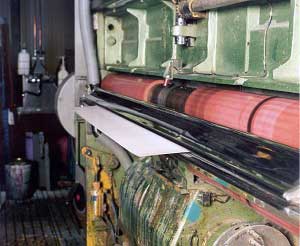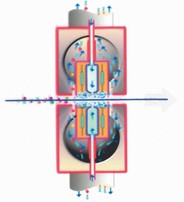Antistatic, static electricity, dust and particle problems
Main menu:
Article about static electricity
Support / Links - PDF > Articles_list
“To install a web cleaner may be relatively straightforward- but how do you choose the right one for your application and to fit your machine? Reinhold Rutks, Swedish Electrostatics, seeks to address these issues.”
The demand for higher through-put, higher quality, less rejects and on-time deliveries (preferably at a price) is an impressive criterion to meet.
However, this is the situation facing us all today. A reclaim due to unwanted particles such as dust, lint, fibers, etc, on an otherwise correct product is a waste of the time and effort involved in the production. Often, this is due to overlooking some very simple facts. Most materials handled converting are isolators, which mean that while being processed they build- up a static charge. Airborne particles and those generated the process due to friction, slitting, cutting, etc are also charged.
Today, there is an increasing number of manufacturing units where production is taking place in a clean-room environ- ment with the associated higher costs that go with it. Static attracts unwanted particles and also hinders the efficient removal from the surface of the material. If the particles around the machine are unavoidable then the build-up of static on the material has to be dealt with.
Before entering into a more detailed discussion about web cleaning it is important to first define the problems with to quality specifications and to identify the particles causing the problem and their origin. A reduction in particles can often be achieved by simple means such as discharg-ing obvious areas of the process, e.g. unwinds and rewinds, feeders and stackers.
System design should take into account the fact that the electrostatic attractive forces are weak at a distance but represent a considerable force when acting on two surfaces in close ‘contact’. When doubling the distance between parallel surfaces the attractive forces decrease by the square, which means particles should be kept either further away, or, the electrostatic potential (static build-up) should be lowered.
In many cases the installation of a web cleaner is a necessity because of product development with new materials as well as demands for higher quality print. This has led to the growing demand for retrofitting of older machines, which may well prove complicated due to existing design constraints.
Another consideration is that many materials which need cleaning are no longer in the form of a web, as they are often processed sheets of materials such as board, glass, plastic, paper, etc and consequently the technical solution becomes more complicated.
It is sometimes questionable whether a single or a double-sided web cleaner should be installed. Some machines do not have room for a double sided web cleaner, but in some situations it could be argued that particles are harmful only on one side of the material – anexample of this is in the printing process.
This may be true, but it should not be forgotten that for longer run jobs an accumulation of particles may be rendered serious after a critical time. What looked like a saving initially may well turn out to be a mistake. Speed is an important factor, not only because static build-up tends to be exponential with speed, but of greater importance is the laminar air flow which will be present in faster moving webs (sheets).  Small particles or particles which are orientated flat to the surface will ‘hide’ in the laminar air flow and be difficult to remove by just applying a vacuum.
Small particles or particles which are orientated flat to the surface will ‘hide’ in the laminar air flow and be difficult to remove by just applying a vacuum.
When dimensioning the suction boxes and vacuum system there is clearly a difference between a 50m/min and a 10m/s material speed. To breakdown the laminar air flow the suction boxes can be designed to create a turbulent air flow or blowing air can be used as an air knife.
With electrostatic attractive forces it is not usually enough to blow a vacuum off the particles. The reason being is that the air flow will apply on the particle must be bigger than the electrostatic attractive force. During the particle’s travel it may not become electrostatically attracted again by the surface before it has been completely removed.
Another complicating factor is the triboelectric charging of material (web, sheet) that when air containing particles move at high speed against a surface.
A relatively new approach to static elimination is to integrate different functions into a unit and this can be described as follows:
Firstly, the web (sheet) is statically charged and carries unwanted particles while moving into the suction unit. It then encounters a strong turbulent air flow consisting of ionised air which effectively removes the electrostatic charges from the web and particles. The blowing air helps lift the particles from the surface which are finally removed via a vacuum extraction slot.
It is important to ensure the expertise is there to provide the correct solutions for the job involved, and customers must specify their particular needs. Once the web cleaning system has been installed it will need monitoring and evaluating – but that’s another story.

Principle of suction design

